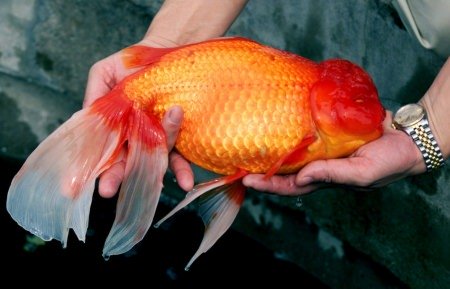| Back to Back Issues Page |
 |
|
The Goldfish Gazette, Issue #089 Pond Feeding May 30, 2021 |
Goldfish Care TipsA Free Monthly Resource For Goldfish Enthusiasts In This Issue The decision on whether to feed or not to feed pond fish depends on many factors, and every pond is different. Pond Feeding
Giant Oranda Caught in Lake St. Clair MichiganI often get asked the question whether pond fish should be fed or not. The question never arises for aquarium fish because common sense tells you no natural foods, apart from aquatic plants introduced by the owner, will find their way into an aquarium in sufficient quantity to feed its occupants.So, my usual answer is, how close is the pond to a natural environment? Natural EnvironmentWe have all seen images of huge Goldfish that have been caught from natural waterways. They can reach massive proportions, far larger than the 1 foot (300mm) maximum size generally accepted for the Common Goldfish.Why is this? Unlimited food, and reasonably clean fresh water in abundance. In a closed environment such as a pond, unless the fish density is extremely low, natural food sources are usually too limited. Assuming you do have a low fish density, how long is that going to last before the fish spawn? As an extreme example, a reader in Canada has a large pond of conservatively 660,000 gallons. Yes, they do things big in Canada. He introduced 30 odd Goldfish into the pond, and by autumn he had thousands of juvenile fish ¾” (19mm) to 3 inches (75mm) in length, and he wanted to know what he was going to feed them, and would they survive winter. Nature has the habit of taking up any excess capacity a pond may have by increasing the fish numbers. Nature also has the ability to regulate fish numbers. As more fish populate a pond, less fry survive due to predation by larger fish, but food is the biggest factor that determines fish numbers. As numbers rise, the limited food source means someone misses out, usually the smaller fish. As winter approaches, heavy feeding builds up fat for a period of hibernation or low activity. If there is not enough food available in autumn, fish with low fat reserves will die come spring. Sustainable Pond CharacteristicsSo, what should a pond capable of sustaining a Goldfish population without feeding look like?Every pond is going to be different due to location, climate and size, but there are a few characteristics that would be a given. Size - Anything under 1000 gallons isn’t going to be able to sustain many fish of a reasonable size, so it will need to be large. Aquatic Plants - Edible aquatic plants such as Elodea Crispa or Elodea Canadensis (oxygen weed) would need to be well established. Position - The pond would need to be close to ground level so worms and other crawling insect life could fall into it. Filtration - A filter probably won’t be installed as the water currents created put off flying insects from laying their eggs, unless an area is created where the Goldfish can't reach and it is protected from any currents. Reversion to TypeIf a pond owner has a pond big enough to sustain a population of Goldfish without feeding, and wants to let nature regulate numbers, there is a problem if the pond is uncovered.A large pond is a magnet to herons and kingfishers. As fry change color, they become more obvious targets for predators than their drab uncolored siblings. Over time, fish that never colored start to become the more dominant color variant, replacing your original gold fish. ConclusionYes, I am sure there are ponds that will sustain a Goldfish population, but at some time intervention will be needed to stop your fish reverting back to drab colored wild goldfish, and fish numbers monitored to ensure enough will survive if there is a bad climatic event such as a hot dry summer.
Comments? Ideas? Feedback? I'd love to hear from you. Just reply to this e-zine and tell me what you think, or what topics you want covered. Next Month's Topic Disease outbreak first stepswww.facebook.com/aboutgoldfish |
| Back to Back Issues Page |
